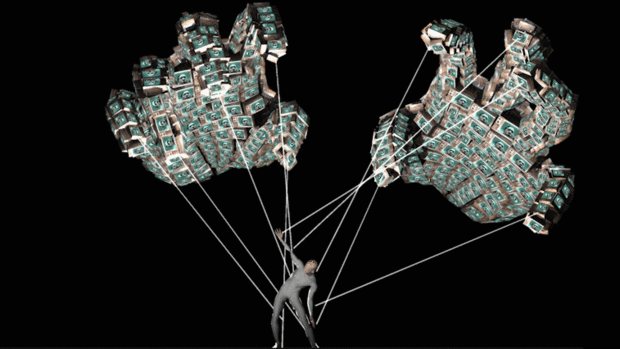Hsin-Chien Huang’s performance art piece creates visual sculptures from dancer movements with 3D printed keepsakes made from motion capture data.
Enschede, The Netherlands -- An exploration of the past is nothing new to the art world; a performance that bends 3D projections to its will, however, is something to see. Blending complex imagery with dance, 3D printing and Xsens motion capture, The Inheritance is earning rave reviews for a story about the spiritual pains that remain in families after a state of national unrest.
Created by Storynest Director, Hsin-Chien Huang, The Inheritance wrestles with a time when Taiwan was under martial law. Closed borders, and the inability to communicate with people outside of Taiwan left many stranded abroad. Aid attempts discovered by the Investigation Bureau resulted in harassment at your home or on the street, leading to a state of constant fear in the populace.
Now that martial law is no more, Huang is still intrigued by state-sanctioned history and everything it conceals. Through The Inheritance, Huang grapples with his family’s struggle, using dance and various forms of new media to turn memories into a form of visual sculpture.
Set in front of a giant screen, the dancers navigate nine chapters of stereographic projections. Unlike some shows, though, the projections are governed by the dancers and the real-time motion capture data they are transmitting.
“We wanted to give the audience a real sense of three-dimensionality,” said Huang. “This way the dancers’ performance seems to extend to the tip of the audience’s nose.”
To achieve this, the team employs the Xsens MVN inertial motion capture suit during the event. With the ability to work outside of a studio, and a 240 FPS capture rate, the team is able to register even the most intricate of details from its dancers. The computer-controlled virtual characters (think: DNA strands, twisted bodies, puppetmaster hands) have been mapped to dancer movements, enabling an interactive experience that builds on each character’s unique AI. Additional premade animation and physics simulations are also loaded into the system, giving Huang the opportunity to use predefined motions when it suits the story.
“Exploration is the only way for me to understand my personal history,” added Huang. “I want to use my hands to experience that journey, and by using the technologies like motion capture and 3D printing, I can transform the trails of my hands into tangible sculptures.”
To manipulate the show in real-time, the performance data is streamed to the crew’s rendering and interactive software. There, the mocap data can be duplicated, mirrored, randomized, delayed, or accelerated in the moment, enabling collaboration between Huang and the dancers, even when communication is impossible.
Using Xsens’ mocap software package, MVN Studio, Huang can record and edit the data and then attach it to whatever character he needs to. “It allows me to replay a dancer’s mocap data again and again, changing what I need to within my interactive program. It’s an excellent way to collaborate with dancers when I’m not in their presence,” said Huang.
While some may see shapes changing before their eyes, Huang sees a chance to make something physical out of the projections. “With accurate mocap data, human hands become a 3D scanner,” continued Huang. “Our walking paths record the contours of the terrain we have travelled; when I convert these paths into 3D models and print them out with a 3D printer, these once ambiguous memories become visible. They can be shared and re-touched.”
This desire has led Huang to 3D print many of the projections the audience sees in the show. What are interpretations of memories for him become active pieces that people can hold and engage with in a whole new way. Giving Huang even more control over a history that others have tried to define for him.
“The future can only be changed if we invent fresh and sincere ways to understand our past,” said Huang. “I want to find new ways to document my private memories.”
The Inheritance was sponsored by the Crossover Fund between Digital and Visual Art from National Taiwan Fine Art Museum, and produced by Ms. You-Chiou Chen of White Egret Foundation. The Choreography Adviser was Le Gend Lin of Legend Lin Dance Theatre, and its first performance was presented at the Chiang Kai-shek Auditorium of the old Taiwan Air Force headquarters in Taipei. The Inheritance is still in development.
Source: Xsens














